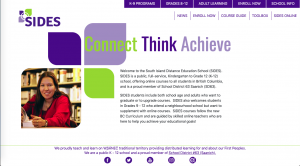At this point in our lives, our generation has been dominated by the everlasting growth and influence of the internet and the type of services that it offers. Everyday, the internet is being used by billions of people all over the world, and it shows with how much our society relies on online services. For example, we see the likes of Black Friday or Boxing day shopping transitioning into appealing to customers to buy online, days before black Friday even begins.

Figure 1 – Best Buy Flyer for a sale that is advertising black Friday prices, a few days before the actual date.
Due to the online shift in society, there should be no surprises that we see this in something that we are all extremely familiar with, that of which is learning (Nguyen, 2015). For users whom like to use online services or resources, the internet and its online resources has benefited all levels of society, ranging from the low-income families to the wealthy business class for years (Mehra, Merkel & Bishop, 2004). This range and its effectiveness of online resources is best seen through the stages of learning that everyone goes through. By looking at this range of people, we can see how different everyone learns and the growth of learning they possess throughout their schooling career. But how effective is online learning really for students or even adults?
At a first glance, we can argue that there are both positives and negatives that online learning comes with. One of the challenges that comes with online learning are the different types of struggles that teachers often face. By not having the chance to use the traditional teaching methods, teachers have to put more effort into teaching (Anderson, 2004). The reason that they have to put more into teaching is that, teachers must think of the fact that students are not present, which is the biggest factor of online learning.
Due to this factor being in place, teachers cannot physically see their students, so they must account for this missing piece by putting extra detail into their instructions. Besides instructions, they must be readily available when students have questions; Essentially, everything that could be done inside the classroom, must be transferred into a virtual classroom that is not confined within a physical building and time-frame.
However, there is not a complete negative connotation for teachers who are willing to take on the challenge of online teaching. Below you’ll find a video on teachers who have experienced online teaching and are sharing their experiences with their audience.
As seen in the video, there are some teachers who actually prefer to teaching online to students and have found ways to benefit them in their ways of teaching. Whether it be by storytelling or having detailed instructions, all these concepts were learned through experiencing them first hand and turning it into an advantageous standpoint for themselves.
The same could be said for students as well, but there is very little negative presence as there is to a teacher’s perspective but is seen in a more positive perspective. In fact, this type of learning is more beneficial for students rather than traditional learning inside a classroom. For a student, the chance to be able to learn online is seen as a luxury and tool that helps benefit the student with flexibility in their lives. Not only does it help with the flexibility of a student’s life, but also helps to develop online communities and connections with others (Dalsgaard & Paulsen, 2009). As a student who is online learning, they have the tools and resources at their fingertips to search the web and connect with others online to help with any type of learning they would need.
For a student, the most important thing that online learning can offer them with is the amount of control that the student can have over the courses’ content (Ruiz, Mintzer & Leipzig, 2006). One of the biggest things that can be controlled is the pace and how much content can be taken in at a time. When you have a learning environment, not everyone can take in information or read and comprehend at the same speed, or learn at the same difficulty level of people who you are grouped with. In all learning situations, this is where online learning can triumph over the traditional way of learning.
Not only is e-learning limited to taking online courses, or writing online essays, but it is an outlet to other ways way of learning. One of the ways that people can access different information or communicate is through blogs and or podcasts (Downes, 2005). By exposing students to this different method, they are given something that is new and inventive that they are not used to.
By finding new and inventive ways outside of classroom learning and involving this more with online resources, this is a concept that fits our generation closely. Due to the fact that we are very technology dominate, we are heavily dependent on technology to provide us with what we need in society. In turn, focusing on e-learning is something that can help further our way of life and have a more diverse way of learning.
After talking about the advantages of e-learning, we can look at what makes e-learning effective for students. According to a study done by Song, the way a course is laid out, the way its managed, and just as a whole, the way it is designed affects student’s success rate with learning (Song, Singleton, Hill & Koh, 2004). To sum it up, the way an e-learning is presented, appearance wise, and how it attracts students, determines how successful this type of learning can be.
As an example, we can look at a popular online schooling website called Sides as an example. This is an online learning program that offers students different programs that range from Kindergarten to Adult level programs and electives.

Figure 2 – Homepage of SIDES learning
For this Learning Management System (LMS), they give some background information on who they are and what they provide. Along with their greeting, they are very encouraging on their homepage to help motivate students want to learn and enroll into the courses they provide. They also, have different tabs that link to useful information, about the different types of learning and the resources that they have readily available to the students.
Just like this Learning Management System, there are hundreds more of these to help provide a different type of learning to students. For students, the pros of e-learning outweigh the pros of traditional learning inside a bricked building, due to the fact that technology and the internet are still growing everyday. By having a diverse way of learning, we can branch out to the different types of learning styles that are in this world. In saying this however, online learning is not something that is supposed to replace the traditional way of learning, but is the same as teammate or partner working together.
Sure, these both could stand on their own, having a rivalry with each other, but utilizing them both to the fullest potential could help further our education for years to come. The first step to this is to hope that one day, online learning will be thought of as equals to the classroom learning methods that we have experienced for ages.
References:
Anderson, T. (2004). Towards a theory of online learning. Theory and practice of online learning, 2, 109-119.
Dalsgaard, C., & Paulsen, M. F. (2009). Transparency in cooperative online education. The International Review of Research in Open and Distributed Learning, 10(3).
Downes, S. (2005). E-learning 2.0. Elearn magazine, 2005(10), 1.
Mehra, B., Merkel, C., & Bishop, A. P. (2004). The internet for empowerment of minority and marginalized users. New media & society, 6(6), 781-802.
Nguyen, T. (2015). The effectiveness of online learning: Beyond no significant difference and future horizons. MERLOT Journal of Online Learning and Teaching, 11(2), 309-319.
Ruiz, J. G., Mintzer, M. J., & Leipzig, R. M. (2006). The impact of e-learning in medical education. Academic medicine, 81(3), 207-212.
Song, L., Singleton, E. S., Hill, J. R., & Koh, M. H. (2004). Improving online learning: Student perceptions of useful and challenging characteristics. The internet and higher education, 7(1), 59-70.